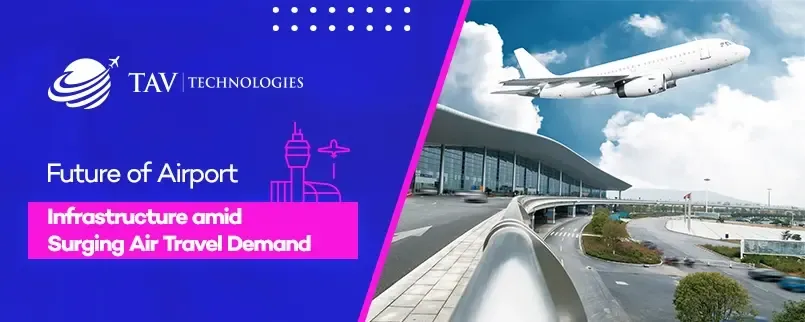
Dec 2023
The aviation industry has witnessed unprecedented growth, with global passenger numbers reaching pre-pandemic levels and projected to continue rising in the coming years. This surge in demand for air travel has placed significant pressure on airport infrastructure, necessitating modernization, expansion, and optimization.
As the increase in demand for air travel extends beyond the crowds seen at security checkpoints, it impacts the data and operations of airlines and airports. Air travel is becoming increasingly popular due to more frequent flights, increased ticket sales, and the expansion of airline fleets. These signals serve as a compass for airports, guiding them toward evaluating and enhancing their infrastructure capabilities to accommodate this upward rotation.
How Does Increasing Air Travel Demand Affect Airports?
The aviation landscape is witnessing a dynamic shift as global air travel demand continues its upward trajectory. Here are several ways in which rising air travel demand can impact airports:
Infrastructure Evolution:
- Increasing passenger numbers demand a physical reconsideration of airports.
- Expansion projects for terminals, runways, and parking facilities are becoming imperative to meet the needs of a growing travel community.
Capacity Crunch:
- With demand comes congestion, prompting the need for strategic optimization and capacity expansion projects.
Tech-Driven Efficiency:
- Airports are embracing advanced technologies, such as automated check-in kiosks, biometric systems, and smart baggage handling solutions.
Sustainability at Altitude:
- Airports are adopting sustainable practices, from electric ground vehicles to renewable energy sources.
Financial Ascension:
- Increased demand means increased revenue, allowing airports to fund improvements, expansions, and enhanced services.
Collaboration in Flight:
- Optimizing schedules and resources requires seamless collaboration between airports and airlines.
Securing the Skies:
- Safety and security regulations take center stage, leading to investments in advanced security measures.
Economic Ripples:
- Increased air travel demand stimulates economic growth, though challenges like traffic congestion accompany this growth.
Key Components of Modern Airport Infrastructure
Modern airport infrastructure goes beyond just runways and terminals. It encompasses state-of-the-art IT solutions provided by companies like TAV Technologies. From robust airport IT infrastructure management to fueling and power systems, these components are the backbone of an airport's ability to handle increased passenger loads efficiently.
The intricacies of airports’ success lie in a sophisticated blend of components seamlessly orchestrated to handle the demands of today's aviation landscape. The key components of airport infrastructure include:
- Terminal Technologies
- Runway and Taxiway Networks
- Airport IT Infrastructure Management
- Fueling and Power Systems
- Air Traffic Control (ATC) Systems
- Security Infrastructure
- Ground Transportation Connectivity
- Environmental Sustainability Measures
- Retail and Commercial Spaces
- Emergency Response and Medical Facilities
How Do Airports Cope with Increasing Passenger Volumes?
As passenger numbers continue to increase, airports are teaming up with technology innovators such as TAV Technologies to leverage the potential of new ideas. TAV Technologies' cutting-edge solutions empower airports to streamline operations, boost security, and transform the passenger experience. From seamless baggage handling to optimized boarding procedures, TAV Technologies' expertise is instrumental in enabling airports to manage the demands of a developing aviation landscape.
In the era of heavy air traffic, more and more data is being collected at airports. That is why airports are leveraging analytics and data-driven insights for informed decision-making. Airport technology solutions provide comprehensive IT infrastructure management, empowering airports with real-time data about passenger flow, resource utilization, and operational trends.
Challenges Airports Face Due to Increasing Traffic
Airports contend with many challenges due to the surge in air travel. Overcrowded terminals result in long queues and congestion, compromising the passenger experience. Extended wait times at check-in, security, and immigration lead to frustration. Baggage handling systems face stress, causing potential delays and mishandling. Accommodating larger aircraft demands significant infrastructure upgrades. Moreover, environmental concerns arise, requiring a balance between growth and sustainability. Outdated technology necessitates investments for smoother operations.
In conclusion, airports face benefits and challenges due to the rising need for air travel. While it presents growth opportunities, it also poses significant challenges in terms of infrastructure management. It is essential to introduce creative solutions that can accommodate the present increase in usage to guarantee the longevity and durability of airport infrastructure.
